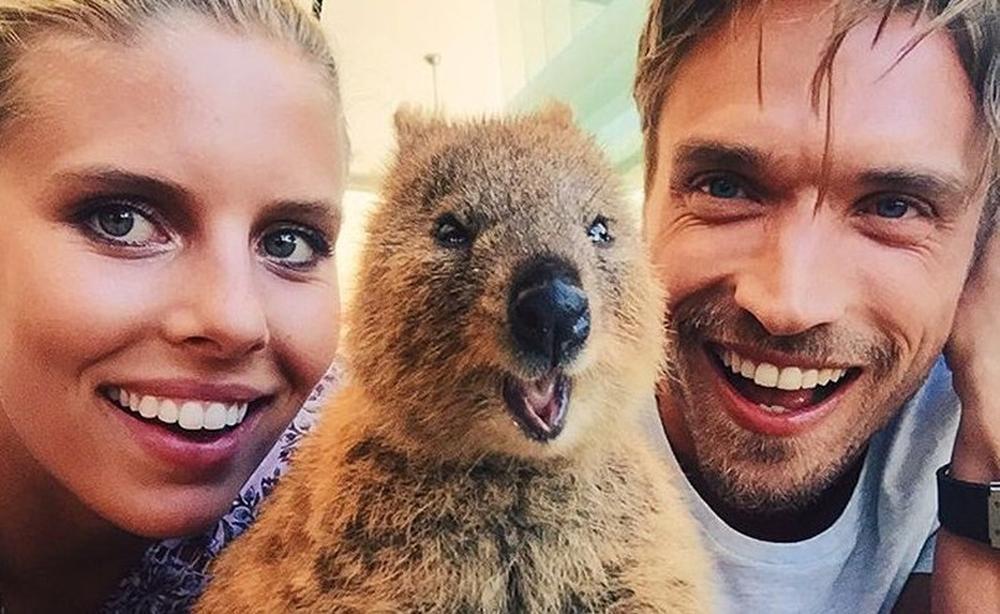This fuzzy little creature is a quokka.
這個毛茸茸的小家伙是短尾矮袋鼠。
And these guys live here off the west coast of Australia on Rottnest Island.
他們生活在澳大利亞西海岸對面的羅特內斯特島上。
Quokkas are not only cute, they are camera ready.
短尾矮袋鼠不僅可愛,還特別會拍照。
And they're taking the internet by storm.
還成了網紅。
So, let's start at the beginning.
我們還是從頭說起吧。
What is a quokka?
什么是短尾矮袋鼠呢?
A quokka is a small wallaby.
短尾矮袋鼠是一種小型袋鼠。
It comes from the same family as a kangaroo.
和我們通常所說的袋鼠是同一個家族的。
And physically they've got thick brown fur, they've got long tails and they hop around.
從生理特征來講,他們有著厚厚的棕色皮毛,尾巴很長,會跳來跳去。
Quokkas thrive on Rottnest Island because they don't have any predators over here, so there's no foxes.
短尾矮袋鼠在羅特內斯特島上繁殖得很好,因為島上沒有掠食者,所以島上沒有狐貍。
We have the largest viable population of about 10,000.
我們最多可以養(yǎng)殖1萬只。
Oh, sorry, and you are?
噢,抱歉,忘了介紹您了。
My name's Cassyanna Gray, and I'm a conservation officer on Rottnest Island.
我是Cassyanna Gray,是羅特內斯特島的保育專員。
In my role I'm responsible for managing conservation programs.
我的工作職責包括管理野生動物保育方案。
And there's one online trend that has really helped these animals.
而一種網絡趨勢對保護這些動物發(fā)揮了重大作用。
A quokka selfie.
那就是和短尾矮袋鼠自拍。

But make sure you're getting it right.
不過務必用正確的姿勢和它們自拍。
How to take a quokka selfie.
那怎么和短尾矮袋鼠自拍呢。
Step one: a camera.
第一步:準備一臺相機。
Step two: a quokka.
第二步:找一只短尾矮袋鼠。
But don't touch the quokkas.
但請不要去摸那些袋鼠。
Ah, no. Or feed them. It's 150 dollar fine.
啊,別摸。也不要給它們喂食。否則是要被罰款150美元的。
These guys don't need the food.
這些小家伙是不需要食物的。
They naturally graze their way through the island's vegetation.
他們天生就是以島上的植物為食的。
And they also really love the seedlings that we plant as part of our re-vegetation projects that we have implemented by our environment technicians.
他們也非常喜歡吃我們種植的幼苗,而那些幼苗是我們的環(huán)保技術員種來恢復島上的植被的。
Sorry about that, guys. Thanks for all your hard work.
同志們,心疼你們。還是要感謝你們的辛勤工作。
And what makes these guys so great for taking selfies?
是什么讓這些家伙如此善于拍自拍照的呢?
Around the settlement area, the quokkas are a lot friendlier; they've become used to people, so their natural behaviors change.
定居點??附近的短尾矮袋鼠會更友好一些,因為他們習慣有人在旁邊了,所以他們的自然行為已經變了。
But out in the reserve where they're actually still exhibiting their natural behavior, they will be a lot more wary of people.
但是在保護區(qū)里,他們還是會表現出它們自然的一面,警惕性會更高。
We have to know, are they actually smiling in photos?
照片里它們是真的在笑嗎?這個問題我們一定要弄清楚。
Yeah, they're not actually smiling in the photos,
嗯,照片里的它們其實并不是在笑,
it's just the natural shape of their mouth, which comes up at the side, which makes them look like they're smiling.
它們的嘴巴天生就是那個形狀,天生就是嘴角上揚的,所以才會讓人覺得它們是在笑。
The popularity of the quokka selfie has given us the opportunity to be able to raise awareness about the quokka's, particularly on the mainland, that are under threat.
短尾矮袋鼠自拍的走紅其實也給了我們一個機會,讓我們意識到,短尾矮袋鼠,尤其是大陸的短尾矮袋鼠,正面臨著威脅。
So we use that as a platform to educate the public and also educate them about appropriate interaction with wildlife.
所以,我們就拿這個當作一個公眾教育平臺,教大家如何正確地與野生動物互動。
So finally, a good cause for selfies.
這倒是自拍的好借口。











